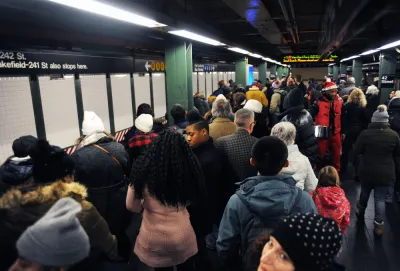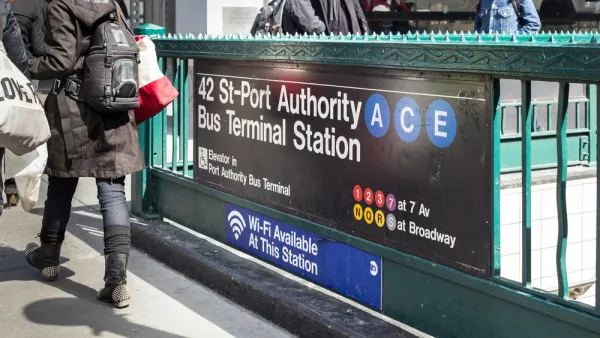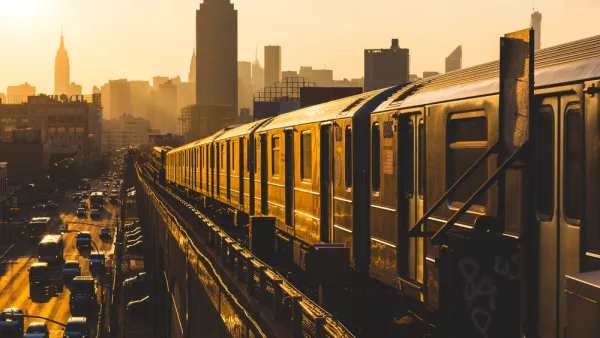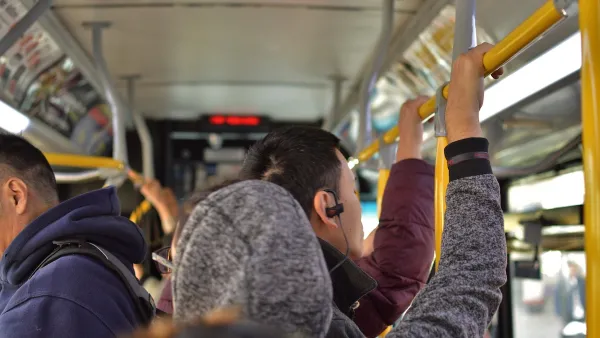With ridership still at less than half of pre-pandemic levels, the region's transit agencies face billions of dollars in budget shortfalls after federal assistance runs out.

Without the crush of pre-pandemic commuters, write Elise Young and Raeedah Wahid, New York City's public transit providers, who "rely heavily on fare revenue for day-to-day expenses," will have to make massive cuts in staff and service after federal pandemic relief dollars run out. With less than half of its typical ridership, New York's Metropolitan Transportation Authority faces a shortfall of billions of dollars.
"The non-profit Regional Plan Association, which researches New York City-area economic and environmental issues, predicts an eventual ridership recovery. But some commuters will trade the 9-to-5 workday for more flexible hours, driving up off-peak travel -- and potentially creating chaos, according to Tom Wright, the association’s president." Off-peak travel, says Wright, "actually puts more pressure on the transit agencies."
According to Redfin, "[r]eal estate in popular New York City suburban commuter hubs continued to soar during the pandemic, but the hotter single-family home market is in areas with little to no mass transit." Workers who are making their return to the city "are finding increased crime rates and vacancies among office towers’ street-level businesses that once teemed with commuters," evidence of the trickle-down effects of reduced workforces in central business districts, whose corporate offices created the need for a wide variety of ancillary services. If, as Richard Florida predicts, central business districts will transform into multi-purpose hubs and "15-minute neighborhoods" less dependent on daily commuters, transit agencies may once again need to readjust their service to cater to new needs and schedules.
FULL STORY: NYC Needs the Commuting Crowds That Have Yet to Fully Return

National Parks Layoffs Will Cause Communities to Lose Billions
Thousands of essential park workers were laid off this week, just before the busy spring break season.

Retro-silient?: America’s First “Eco-burb,” The Woodlands Turns 50
A master-planned community north of Houston offers lessons on green infrastructure and resilient design, but falls short of its founder’s lofty affordability and walkability goals.

Delivering for America Plan Will Downgrade Mail Service in at Least 49.5 Percent of Zip Codes
Republican and Democrat lawmakers criticize the plan for its disproportionate negative impact on rural communities.

Test News Post 1
This is a summary

Test News Headline 46
Test for the image on the front page.

Balancing Bombs and Butterflies: How the National Guard Protects a Rare Species
The National Guard at Fort Indiantown Gap uses GIS technology and land management strategies to balance military training with conservation efforts, ensuring the survival of the rare eastern regal fritillary butterfly.
Urban Design for Planners 1: Software Tools
This six-course series explores essential urban design concepts using open source software and equips planners with the tools they need to participate fully in the urban design process.
Planning for Universal Design
Learn the tools for implementing Universal Design in planning regulations.
EMC Planning Group, Inc.
Planetizen
Planetizen
Mpact (formerly Rail~Volution)
Great Falls Development Authority, Inc.
HUDs Office of Policy Development and Research
NYU Wagner Graduate School of Public Service





























